
Republic, 12 Chapters, 1943. Starring Tom Steele, Louise Currie, Johnny Arthur, Anthony Warde, William Forrest, David Bacon, Rod Bacon, Richard Clarke, Bill Healy.
The Japanese spy-master Mura Sakima (Johnny Arthur) launches a sabotage campaign against wartime America’s defense industries, with the help of ex-racketeer “Killer” Mace (Anthony Warde) and other American turncoats. An undercover detective known only as The Masked Marvel sets out to stop the sabotage, with the help of four insurance investigators (Dave Bacon, Rod Bacon, Richard Clarke, and Bill Healy); only Alice Hamilton (Louise Currie), the daughter of a murdered insurance executive, knows that one of the four is also the Marvel himself.
The Masked Marvel, like director Spencer Bennet’s other solo effort at Republic (Secret Service in Darkest Africa), features a non-stop parade of spectacularly destructive fights and explosions, all of them staged and executed with consummate skill. While the serial comes up short in other departments–particularly acting and plotting–its action setpieces still make it a very entertaining chapterplay, albeit one that falls far short of Republic’s Golden Age standards.
Royal Cole, Basil Dickey, Grant Nelson, Ronald Davidson, Jesse Duffy, George Plympton, and Joseph Poland are credited with Masked Marvel’s screenplay, although one wonders why it took seven writers to come up with such a basic narrative. Their storyline consists simply of a series of largely unrelated espionage and sabotage plots and the Marvel’s counter-moves against the successive schemes; each clash between hero and heavies invariably leads to a slam-bang battle that generally culminates in an explosion. Once a villainous scheme is thwarted, this cycle is promptly repeated, with the villains only occasionally varying the formula through their attempts to unmask the Marvel.

Above, from right to left: William Forrest, Louise Currie, Richard Clarke, Bill Healy, Rod Bacon, and David Bacon listen to a recording that gives them their latest assignment from the Masked Marvel.
The mystery-hero gimmick, borrowed from The Lone Ranger, was obviously intended to enliven Marvel’s repetitious storyline, but doesn’t really add much to the serial; the notion was pointless enough in Ranger but seems even sillier here. The Marvel, unlike the Ranger, lacks even a symbolical motive for concealing his identity; he also gives no reason for arbitrarily revealing said identity to the heroine in the first chapter. The villains’ obsession with uncovering the Marvel’s identity seems equally irrational, since all of the “suspects” thwart Sakima’s schemes nearly as often as the Marvel does. Even the deaths of two of the four suspects lack impact–partly because of the actors playing the roles (more on that below)–but also as a result of the serial’s breakneck pacing, which gives us no time to become attached to the co-heroes.
Location shooting in The Masked Marvel is–due to war-related restrictions–minimal; there are none of the chases through actual plants or factories that marked earlier sabotage-themed serials like Dick Tracy’s G-Men or Spy Smasher. Aside from two harbor sequences, the train-pursuit scene, and a few short car chases, virtually all the action takes place indoors or on the streets and rooftops of the Republic backlot. However, by shooting most of these backlot scenes (and a majority of the other action sequences) at night, director Bennet and cameraman Reggie Lanning give the serial a distinctive visual atmosphere, appropriately creating the impression of a besieged and blacked-out wartime metropolis.
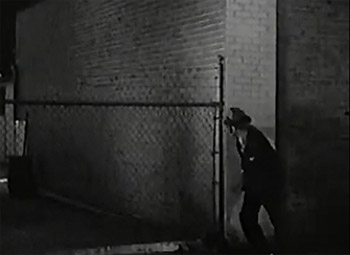
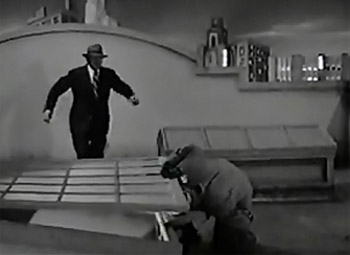
Above left: Tom Steele scouts near a defense plant’s fence. Above right: A henchman sneaks up on a snooping Steele on a rooftop.
Although Masked Marvel’s action scenes are so numerous and so frequent as to practically cancel each other out at times, they represent director Bennet and the 1940s Republic stunt team at their talented peak. Tom Steele is especially spotlighted here, not only playing the Masked Marvel and handling all the character’s stuntwork, but also doubling for most of the investigator co-heroes at one time or another. Duke Green substitutes for lead henchman Anthony Warde and incorporates many spectacular leaps into his innumerable fights with Steele; Dale Van Sickel, Fred Graham, Johnny Daheim, Ken Terrell, Eddie Parker, Carey Loftin, and Joe Yrigoyen participate in many of the set-busting, prop-smashing brawls as well, as minor henchmen and as doubles for principal actors.
The double fight scene in Chapter One, with one investigator battling Green outside a warehouse and a second battling Warde and Graham inside it, is one of many action highlights and also shows off the virtuosity of Republic’s editors; Steele doubles both good guys in the seemingly simultaneous fights, with Green doing similar double duty by standing in for Warde. Other standouts include the fight between Steele, Van Sickel, and Green atop the gas tank later in Chapter One, the tremendous office-building battle in Chapter Five, the fight at the “Super-X” plant in Chapter Eight, and the fight in Sakima’s headquarters in Chapter Ten (during which Ken Terrell, doubling Johnny Arthur, performs some incredibly gymnastic stuntwork).




Above, top left: Ken Terrell makes a flying leap onto Tom Steele. Top right: Steele and Duke Green demolish a laboratory. Bottom left: Steele and Green topple more props at a chemical plant. Bottom right: Steele slugs Eddie Parker in the serial’s final fight scene.
The Chapter Three fight/chase sequence at one of the villains’ hideouts is also memorable, as are the Chapter Six cafe fight, the dockyard-warehouse shootout later in the same episode, the Marvel’s Chapter Ten race to prevent the destruction of a train, the Marvel’s Chapter Eleven boat pursuit of a grenade-chucking Mace, and the Chapter Twelve fight between the Marvel and Sakima’s butler (Eddie Parker). The climactic darkened-room shootout between Sakima and the Marvel is very good as well, culminating with an unexpected comeuppance for the villain that neatly spoofs one common serial convention and adds an unexpected but welcome touch of wit to the finale.
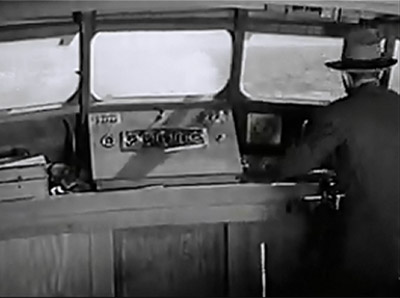
Above: Steele drives a launch into spray kicked up by Anthony Warde’s hand grenades.
The cliffhanger sequences feature plenty of phenomenal miniature work by the Lydecker brothers; the gas-tank explosion at the end of Chapter One, the truck-off-the-pier scene that finishes Chapter Six, the truck crash at the end of Chapter Eight (which boasts an extremely nifty resolution), the collision of an auto with an explosives-laden railcar at the conclusion of Chapter Ten, and the Chapter Eleven launch explosion are particularly memorable. Of the less spectacular endings, the Marvel’s Chapter Three fall down an elevator shaft is the best; the “dramatic” ending to Chapter Four, in which Sakima apparently learns the Marvel’s identity falls flat, while the Marvel’s apparent shooting by Mace at the end of Chapter Seven, though neatly staged, is marred by an unnecessary cheat resolution.


Above left: The giant gas-storage tank explodes. Above right: The truck crashes through the warehouse wall.
The serial’s cast is a decidedly mixed bag, some of them doing their best to make the (scarce) dialogue scenes match the energy level of the action sequences, while others turn in merely adequate performances. Tom Steele, no great shakes at delivering dialogue (as his many acting bits in Republic’s serials show) is wisely dubbed but does a fine job of physical acting as the Marvel; he wears the mask in all the character’s scenes and manages to convincingly convey alarm, determination, and a cat-like alertness. Radio actor Gayne Whitman, who delivers the dubbed lines for Steele, does an excellent job; his voice is dignified, tough, and authoritative, while he also manages to sound as if he’s reacting to the (separately-recorded) dialogue of the other characters instead of merely booming out his lines in a vacuum (unlike the occasionally over-stentorian Billy Bletcher in The Lone Ranger).
The actors playing the four investigators are the weakest performers in the serial; they’re completely lacking in charisma, and pale beside the likable and interesting hero-suspect groups in both Lone Ranger and Flying G-Men. The lanky, New-England-accented David Bacon, in real life a Harvard graduate from a politically prominent family, goes through the serial with a peeved expression and aloof manner, as if he is irritated at having to appear in a serial at all. Handsome and clean-cut Richard Clarke looks the part of a serial hero more than the others, but handles his dialogue in extremely somnolent fashion. Rod Bacon gives the best performance of the four; although his round face makes him look slightly comic, he delivers his lines with more eagerness and energy than his co-heroes. Stocky Bill Healy, as the fourth investigator, is not only lifeless in his dialogue delivery but is physically miscast as well; his general appearance is more reminiscent of a minor thug than a good guy–which also makes him an utterly unconvincing Marvel suspect, given the difference in bulk between him and Steele.


Above left: David Bacon and Billy Healy. Above right: Rod Bacon and Richard Clarke.
Fortunately, Louise Currie is on hand as the heroine, giving us someone to root for on the protagonists’ side besides the necessarily remote Marvel and the uninteresting investigators; her good looks, cheerfulness, and quietly resolute feistiness make her an enormously appealing heroine and help her to carry several scenes almost single-handed. Anthony Warde is similarly terrific (though decidedly less appealing) as ruthless henchman Mace–viciously threatening Currie, snarling angrily every time the hero shows up, tossing off sardonic comments, gloating over successes, and grumbling every time something goes wrong.
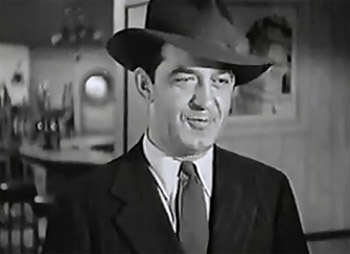
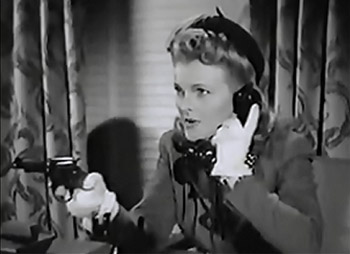
Above: Anthony Warde and Louise Currie.
William Forrest, as the supposedly trusty insurance executive Crane, turns in a bland but capable performance, his slickly dignified business-executive manner making his ongoing deception of the good guys quite convincing. Johnny Arthur is far more colorful as the crafty and confident Sakima; his casting here has frequently been ridiculed by viewers familiar with his milquetoast turns in numerous Hal Roach comedy shorts, but he actually handles his offbeat role very well. More convincing in Japanese makeup than most Occidental actors, he makes his villain smug, unctuous, and rather serpentine, but is never excessively hammy; his condescending sneer every time he mentions “the Marvel” or “the American war effort” is particularly effective, and must have had the kids in the wartime audience booing him loudly.
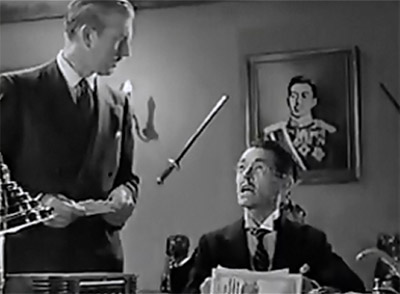
Above: William Forrest and Johnny Arthur.
Howard Hickman plays the heroine’s ill-fated father in the first chapter, while Thomas Louden is her butler; Lester Dorr has a bit as an aggressive reporter and Kenneth Harlan pops up as both a plant guard and a policeman. Harry Woods is wasted in a bit as a henchman (he has a handful of lines and then gets into a fight in which he’s doubled by Fred Graham, leaving me puzzled as to why Graham didn’t simply handle both dialogue and fight). Horror-movie icon Edward Van Sloan appears briefly as a scientist, Forbes Murray plays a doctor, and Herbert Rawlinson is an industrial leader. Roy Barcroft has a small part as a crooked diner manager, while Bud Geary and Tom London appear as truckers, George Pembroke as an air-raid warden, Sam Flint as a police sergeant, Nolan Leary as a gas-station attendant, George J. Lewis as a crooked lawyer, and Ernie Adams as a warehouse manager. Most other speaking roles are filled by the stuntmen, the majority of whom play more than one part–except for Eddie Parker, who appears throughout the serial in the single role of Crane’s butler.
The Masked Marvel’s impressive action sequences have frequently caused it to be overrated by admirers of Republic’s stuntwork and effects (most notably the great serial buff Alan Barbour, who tended to treat it as one of the studio’s masterpieces); this overrating has in turn led other reviewers (particularly those of the Internet generation) to criticize Marvel far more harshly than it deserves, sometimes dismissing it as completely uninteresting. While it’s quite true that Masked Marvel could have been a much better serial had its plotting and casting been handled with the same care bestowed on its action scenes, it’s still far from a failure–and remains well worth the time of any serious chapterplay fan.
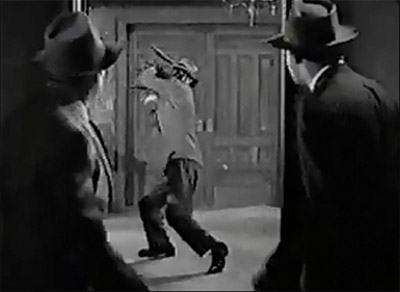
Above: Tom Steele prepares to smash into the heavies’ behind-the-mirror hideout and start another tremendous fight.
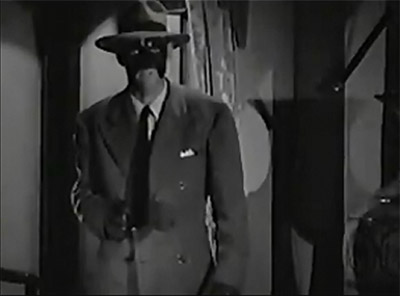
Your excellent review not withstanding,I really enjoyed this serial. Again this is another serial that i saw first run in a theater.At age nine, those poor performances that you and i take note of today, never bothered me in the least. All that interested me was the many fights and explosions.I have it on cassette and still watch it on occasion.Im not as forgiving today of its many flaws as as I was in 1943.Tho not in my top ten,it is in my top twenty.
Jerry,
Another great review and again I don’t necessarily agree with you totally, but that said you did bring out some points that show the serial could have been better but in my eyes its one of the best serials made at Republic. Spencer Bennett loved to destroy stuff and in this serial he did in spades and I think he made his best sound serials at Republic. The Lydecker Brothers or Howard solo did some of the best work again in this serial.
Barcroft
An excellent review giving both the strengths and weaknesses of this serial. I really like Warde and Arthur in their villain turns. **** out of *****
Great review and I agree that the serial suffers from lack of character development, wooden acting by the heroes and a dearth of interesting outdoor scenes. Maybe the sparse linear development is meant to convey a sense of desperate wartime urgency. Once this thing starts it barrels headlong through 12 chapters without digression.
Ultimately though I’m as fanatic about it as AGB was and find it one of the most exciting adventures I’ve ever seen. As you noted, the second unit and miniature work was breathtaking, featuring some of the wildest and best choreographed donnybrooks, and calamitous outcomes for real and personal property ever filmed. How can you beat Sakima’s first shellacking in his hideout in one of the later chapters? The music was also good, surprisingly the cues from Undersea Kingdom didn’t sound dated.
But what chance do I have to be a dispassionate reviewer of a Republic serial? When the mere appearance of Tom London and Bud Geary as extras earns a whoop and a holler objectivity is definitely in question!
“The Masked Marvel” certainly delivers but for me it has a hollow core. The problem is that it’s main hero as well as his possible alter egos are mere plot devices. The Masked Marvel is an enigma while the four (wooden) insurance investigators seem to only exist to provide a guessing game for the audience. That leaves the lovely Louise Curre who’s infectious charm makes her the only relatable protagonist in the serial.
That said, I thoroughly agree with this judicious review but I also understand why “The Masked Marvel” is such a fan favorite.
I agree with the review for the part, however, I think this serial contains some of the greatest fight scenes and special effects ever put on fim, serial or big budget, major studio feature. Who was doing better action than this in 1943? I rate this as one of my all time favorites and going out on a limb, one of Republc’s finest serials.
I recall seeing most of this 12 chapter serial as a child on afternoon television in the late 1960’s. Due to whatever was going on at the time I never saw the final chapters, so I never viewed the conclusion until now. I recently watched the entire 12 chapters (over three nights) on YouTube. I enjoyed this review, it definitely points out the best and worst elements of the serial. As a child I was happy with the fact that there was no clutter in the plot, it was straight to work, each episode loaded with action and I thought some of the cliffhangers were more interesting than the standard serial fare. For example, when The Masked Marvel falls off the gas tower, I didn’t understand as a kid and watching it again as an adult, how he survived the fall (add that to the fact he had to jump right up and escape the soon to explode vehicle). We all know that serials had their own logic, hats don’t come off during fights, leaping out of cars going 60 plus miles an hour is roughly the equivalent of getting out of bed in the morning, and most of the furniture is about as durable as a pliers purchased at a 99 cent store, but still! In the chapter where Jeff Arnold is killed, The Masked Marvel is shot, OK he survives, but that’s not exactly a mosquito sting, there is no blood, no aftereffect, how is that possible.
I enjoyed the discussion about the need for the mask never being established, in chapter 11, Alice is taken by Mace with The Masked Marvel slowing down momentarily to put his mask on before beginning pursuit, why? What difference would it make to Mace if he is being pursued by The Masked Marvel or one of the investigators. I didn’t think about it as a kid, but watching it as an adult you realize pretty early on that The Masked Marvel isn’t any of the investigators (he only vaguely resembles one), and the voice doesn’t sound like any of the actors.
Thanks for write-up.
All of the positives and negatives have been thoroughly discussed, and I really can’t disagree with any of them. It’s still an enjoyable serial, even given the repetitious nature of the storyline and the uncharismatic leads. It may sound odd, but my favorite bits where the few times when Fred Graham turned up. There’s just something about his fight scenes that I never tire of watching. He really could make a punch look convincing!
One other random thought. He has more screen time than in any other role of his career, but Tom Steele not only has his dialogue dubbed, but he doesn’t even appear in the credits. For any actor, that has to be the ultimate double whammy! I can definitely understand the use of a different actor for the voice, but his lack of any billing seems really strange, especially given that performers with much smaller parts did receive credit.